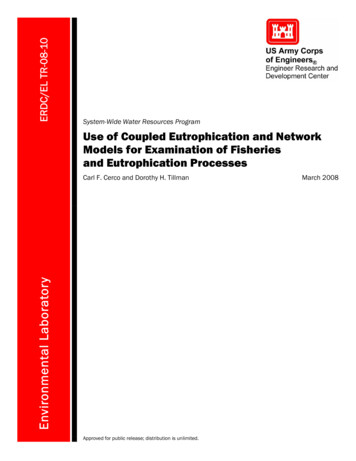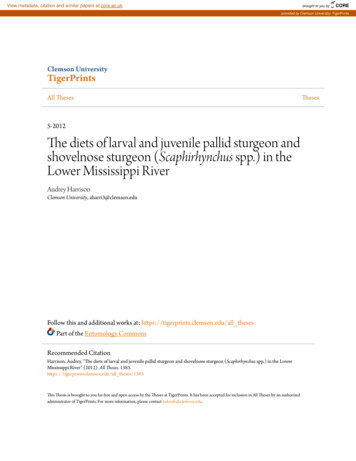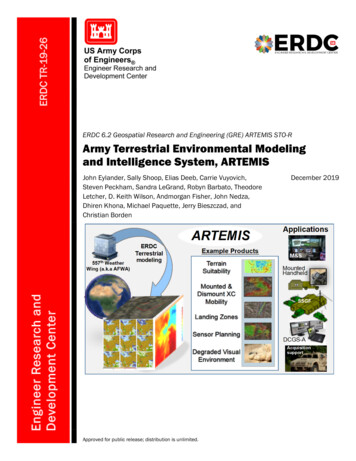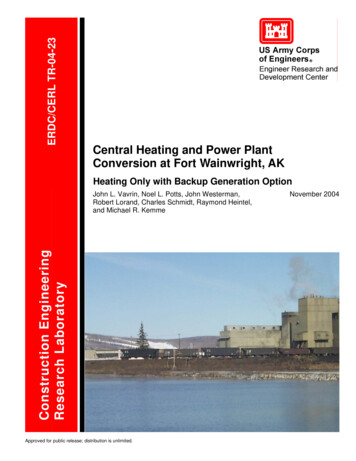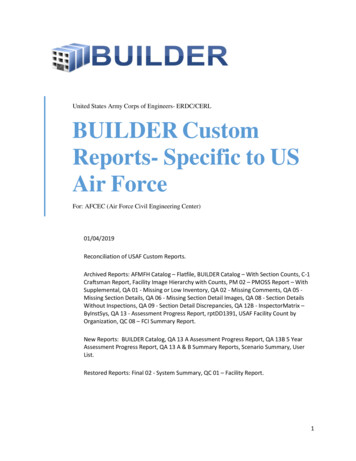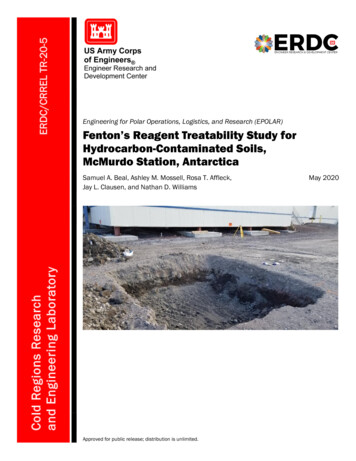
Transcription
ERDC/CRREL TR-20-5Engineering for Polar Operations, Logistics, and Research (EPOLAR)Fenton’s Reagent Treatability Study forHydrocarbon-Contaminated Soils,McMurdo Station, AntarcticaCold Regions Researchand Engineering LaboratorySamuel A. Beal, Ashley M. Mossell, Rosa T. Affleck,Jay L. Clausen, and Nathan D. WilliamsApproved for public release; distribution is unlimited.May 2020
The U.S. Army Engineer Research and Development Center (ERDC) solvesthe nation’s toughest engineering and environmental challenges. ERDC developsinnovative solutions in civil and military engineering, geospatial sciences, waterresources, and environmental sciences for the Army, the Department of Defense,civilian agencies, and our nation’s public good. Find out more at www.erdc.usace.army.mil.To search for other technical reports published by ERDC, visit the ERDC online libraryat http://acwc.sdp.sirsi.net/client/default.
Engineering for Polar Operations, Logistics,and Research (EPOLAR)ERDC/CRREL TR-20-5May 2020Fenton’s Reagent Treatability Studyfor Hydrocarbon-Contaminated Soils,McMurdo Station, AntarcticaSamuel A. Beal, Ashley M. Mossell, Rosa T. Affleck, and Jay L. ClausenU.S. Army Engineer Research and Development Center (ERDC)Cold Regions Research and Engineering Laboratory (CRREL)72 Lyme RoadHanover, NH 03755-1290Nathan D. WilliamsAntarctic Support ContractLeidos11951 Freedom DriveReston, VA 20190-5640Final ReportApproved for public release; distribution is unlimited.Prepared forUnderNational Science FoundationOffice of Polar ProgramsAntarctic Infrastructure and Logistics2415 Eisenhower AvenueAlexandria, VA 22314Engineering for Polar Operations, Logistics, and Research (EPOLAR)EP-ANT-18-80, “Hydrogen Peroxide / Fenton’s Reagent Treatability Study ofMcMurdo Station Hydrocarbon-Contaminated Soil”
ERDC/CRREL TR-20-5AbstractHydrocarbon-contaminated soil is distributed heterogeneously atMcMurdo Station, Antarctica, which has served for over 60 years as the logistics hub for the U.S. Antarctic Program. Here we investigated the treatability of McMurdo Station’s contaminated soil with chemical oxidation.Our study collected five soil samples in 2018 and 2019, of which two contained high levels ( 100 mg/kg) of total petroleum hydrocarbons (TPH)suitable for the treatability study. One soil (ITC) was characterized by 1250mg/kg of predominantly midrange (n-C8 to n-C16) hydrocarbons, and theother (Soil Pile) was characterized by 3500 mg/kg of predominantly heavymolecular weight ( n-C21) hydrocarbons. We investigated the treatabilityof these soils with both Fenton’s Reagent (pH 3 with Fe2 ) and modifiedFenton’s Reagent (chelated Fe2 ), each with hydrogen peroxide concentrations of 3% and 10%. Soil slurries were placed on a shaker table at 100 rpmand 4 C for up to 21 days. TPH concentrations were reduced by approximately 50% for ITC; however, the oxidative treatments did not out-perform controls. All treatments and controls yielded no significant reductionin Soil Pile TPH. Poor performance by these chemical oxidation treatments indicates that remediation of hydrocarbons at these sites may require further soil processing in combination with chemical oxidation or alternative treatment technologies.DISCLAIMER: The contents of this report are not to be used for advertising, publication, or promotional purposes. Citation of trade names does not constitute an official endorsement or approval of the use of such commercial products.All product names and trademarks cited are the property of their respective owners. The findings of this report are not tobe construed as an official Department of the Army position unless so designated by other authorized documents.DESTROY THIS REPORT WHEN NO LONGER NEEDED. DO NOT RETURN IT TO THE ORIGINATOR.ii
ERDC/CRREL TR-20-5ContentsAbstract . iiFigures and Tables .ivPreface .vAcronyms and Abbreviations .vi1Introduction . 11.1 Background . 11.2 Objectives . 31.3 Approach . 32Methods . 42.12.22.32.42.53Soil sampling and shipment . 4Sample processing . 5Treatability study design . 5Treatability study procedure . 6Sample analysis . 7Results and Discussion. 83.13.23.33.43.5Soil characteristics . 8Study optimization . 9Study observations . 10Treatability results . 10Limitations and field-scale applicability . 134Conclusions .155Recommendations.16References .18Appendix A: Supporting Figures and Data.21Report Documentation Pageiii
ERDC/CRREL TR-20-5Figures and TablesFigures1Sampled sites where hydrocarbon contamination was suspected . 52Representative GC-FID chromatograms for ITC F1 and Soil Pile extracts.Retention times for n-alkane marker compounds are shown in gray. 93Air temperatures adjacent to the experiment’s shaker table during the 21day experiments. The dashed line represents the mean temperature .104Posttreatment TPH concentrations in ITC F1 and Soil Pile samples byreaction time and treatment type. The dotted lines represent mean 1standard deviation bounds of pretreatment TPH concentrations .115Posttreatment HMW concentrations in Soil Pile samples by reaction timeand treatment type. Dotted lines represent mean 1 standard deviationbounds of pretreatment HMW concentrations .13A-1GC-FID chromatograms of soil samples and the hydrocarbon standards fordiesel (5000 mg/L), gasoline (500 mg/L), JP-5 (5000 mg/L), JP-8 (5000mg/L), and hydraulic oil (500 mg/L). The gasoline standard signal is 5 for plotting .21A-2Posttreatment TPH concentrations in ITC F1 samples by reaction time andtreatment type. Dotted lines represent mean 1 standard deviationbounds of pretreatment TPH concentrations . 21A-3Posttreatment TPH concentrations in Soil Pile samples by reaction timeand treatment type. Dotted lines represent mean 1 standard deviationbounds of pretreatment TPH concentrations .22A-4Posttreatment HMW concentrations in Soil Pile samples by reaction timeand treatment type. Dotted lines represent mean 1 standard deviationbounds of pretreatment HMW concentrations .22Tables1Soil-sample descriptions . 42Five treatment levels used in batch experiments. Volumes of pH modifierwere to be determined (TBD) experimentally for each soil, discussed inSection 3.2. 63Soil particle size from sieving (whole sample) and initial TPH results for the 2 mm fraction (average one standard deviation) on triplicatesubsamples . 84Acid addition optimization results for Fenton’s Reagent treatment . 95Treatability results for Soil Pile at room temperature and 4 C over 4 days .13A-1Experimental data for ITC F1 .23A-2Experimental data for Soil Pile . 24iv
ERDC/CRREL TR-20-5PrefaceThis study was conducted for the National Science Foundation (NSF), Office of Polar Programs (OPP), Antarctic Infrastructure and Logistics Program (AIL), under Project EP-ANT-18-80, “Hydrogen Peroxide / Fenton’sReagent Treatability Study of McMurdo Station Hydrocarbon-Contaminated Soil.” The technical monitor was Ms. Margaret Knuth, OperationsManager, NSF-OPP-AIL, U.S. Antarctic Program.The work was performed by the Biogeochemical Sciences Branch (BSB)and the Force Projection and Sustainment Branch (FPSB) of the Researchand Engineering Division, U.S. Army Engineer Research and DevelopmentCenter, Cold Regions Research and Engineering Laboratory (ERDCCRREL). At the time of publication, Dr. Gina Ralph was Acting Chief, BSB;Mr. Justin Putnam was Acting Chief, FPSB; and Mr. J. D. Horne was Division Chief. The Deputy Director of ERDC-CRREL was Mr. David B. Ringelberg, and the Director was Dr. Joseph L. Corriveau.The authors gratefully acknowledge Ms. Anne Hellie and Ms. SpringWood, formerly with Leidos, Antarctic Support Contract (ASC), for the report on their Fenton’s Reagent study on the McMurdo soil pile. The authors also acknowledge the assistance by ASC staff in collecting, packaging, and shipping samples.COL Teresa A. Schlosser was Commander of the ERDC, and Dr. David W.Pittman was the ERDC Director.v
ERDC/CRREL TR-20-5viAcronyms and AbbreviationsAILAntarctic Infrastructure and Logistics ProgramASCAntarctic Support ContractBSBBiogeochemical Sciences BranchCRRELU.S. Army Cold Regions Research and Engineering LaboratoryEDTAEthylenediaminetetraacetic Acid, a ChelateEPOLAREngineering for Polar Operations, Logistics, and ResearchERDCEngineer Research and Development CenterFe(II)SO4 7H2OIron SulfateFPSBForce Projection and Sustainment BranchFRFenton’s ReagentGC-FIDGas Chromatography with a Flame Ionization DetectorHMWHigh Molecular Weight Petroleum CompoundsH2O2Hydrogen PeroxideH2SO4Sulfuric AcidITCInformation Technology and CommunicationsITC F1Information Technology and Communications First FoundationFooterMFRModified Fenton’s ReagentNSFNational Science FoundationOPPOffice of Polar ProgramsppmParts per MillionrpmRevolutions per MinuteTBDTo Be Determined
ERDC/CRREL TR-20-5viiTPHTotal Petroleum HydrocarbonsUSDAU.S. Department of AgricultureUSAPU.S. Antarctic ProgramVMFVehicle Maintenance FacilityVMF7Vehicle Maintenance Facility Bay 7
ERDC/CRREL TR-20-51Introduction1.1BackgroundMcMurdo Station, located on the Hut Point Peninsula, Ross Island, Antarctica, serves as the logistics hub for the U.S. Antarctic Program (USAP),which is managed by the National Science Foundation (NSF). McMurdoprovides research and science support across the continent of Antarctica,including to Amundsen-Scott South Pole Station. McMurdo Station’s existing facilities were constructed on an outcrop of barren volcanic rockmodified to form a series of flat fill platforms (Affleck et al. 2017). Initiallyestablished in 1955, McMurdo Station has grown to include approximately100 buildings, three runways, and a helicopter pad.Soil contamination by fuel and lubricating oil spills occurs in patches acrossMcMurdo Station. Areas of high contamination, characterized by total petroleum hydrocarbons (TPH) greater than 500 parts per million (ppm), areconcentrated near fuel storage tanks (formerly used and current), refuelingstations, vehicle maintenance facilities, a landfill, and vehicle parking areas(Klein et al. 2012). High molecular weight petroleum compounds (HMW)are present primarily in areas where vehicles are parked and are not associated with fuel tanks and refueling stations (Klein et al. 2012). The dominantfuels used at McMurdo since its construction have been JP-5, JP-8, AN-8 (aspecial low-freezing-point fuel), and MOGAS (unleaded gasoline; Klein etal. 2008; Haehnel et al. 2017). Between 2005 and 2015, USAP purchasedapproximately 19 million liters per year total of JP-5, AN-8, and gasoline(Haehnel et al. 2017). Unlike some other Antarctic bases, diesel is not a primary fuel at McMurdo (Aislabie et al. 2004).The fate and transport of hydrocarbons depend on the type of fuel spilledand the soil structure. Gasoline and lighter components of the jet fuels JP5, JP-8, and AN-8 readily volatilize at the surface and, due to their lowerviscosity, are also more mobile than diesel and oils (Aislabie et al. 2004).Hydrocarbon permeation in soil overlying permafrost may be limited to theactive layer, as permanently frozen soil acts as a physical barrier in the absence of any cracks or fissures (Aislabie et al. 2004). However, a suspectedhydrocarbon layer in the ice-cemented substrate underneath frozen soil atMcMurdo Station was identified in soil pits and cores (Affleck et al. 2017)and in ground-penetrating-radar surveys (Campbell et al. 2018). Runoff1
ERDC/CRREL TR-20-5measured from major McMurdo drainages during a period of thaw did notyield any petroleum hydrocarbon concentrations above the detection limits(40–300 µg/L; * Affleck et al. 2014), which indicated contaminants wererelatively adsorbed in place and minimally displaced by snowmelt.Current building development on McMurdo station needs to manage potentially contaminated soils and to find inexpensive management solutions compared with off-site disposal (NSF 2019). Unfortunately, in coldregions like McMurdo Station, hydrocarbons can persist and accumulateover long periods of time due to low biological activity, low soil moisture,low nutrient levels, and slow reaction kinetics (Affleck et al. 2017; Aislabieet al. 2004; Eriksson et al. 2001; Klein et al. 2012). This slow natural attenuation explains elevated TPH concentrations near previously removedfuel tanks at McMurdo (Klein et al. 2012) and hydrocarbon off-gassingfrom soil pits (Affleck et al. 2017) and soil cores (Fenwick and Winkler2016; Fenwick et al. 2017). At Old Casey Station, Antarctica, biodegradation stimulated with added nutrients resulted in only a 15% decrease insoil diesel concentrations (Ferguson et al. 2003).Chemical oxidation has been a successful method for remediating petroleum-contaminated soil at more temperate locations. Though there aremany chemical oxidants, Fenton’s Reagent has been among the most popular. Fenton’s Reagent involves the reaction of hydrogen peroxide (H2O2)with Fe2 to form the reactive hydroxyl radical and Fe3 . Classic Fenton’sReagent uses 0.03% H2O2, but field applications require higher concentrations (Interstate Technology and Regulatory Council 2005). Typically,acidic conditions improve TPH degradation by reducing Fe3 to the moresoluble Fe2 (Watts 1992). There have been numerous modifications toFenton’s Reagent, which in many cases use chelates to improve iron solubility and availability without the need for acidic conditions (e.g., Kakarlaet al. 2002). Lab-scale studies on petroleum-contaminated soil in temperate regions typically observe 50% or greater reduction in TPH with Fenton’s Reagent and Modified Fenton’s Reagent treatments (Lu et al. 2010;Mater et al. 2007; Tsai and Kao 2009).*For a full list of the spelled-out forms of the units of measure and chemical elements used in this document, please refer to U.S. Government Publishing Office Style Manual, 31st ed. (Washington, DC: U.SGovernment Publishing Office, 2016), 248–252, 265, L-2016/pdf/GPO-STYLEMANUAL-2016.pdf.2
ERDC/CRREL TR-20-5At low temperatures, decreased kinetics may inhibit Fenton’s Reagent performance. However, a recent study found complete degradation with H2O2treatment on Arctic soil at 4 C (Sherwood and Cassidy 2014). To date, onlyone published study has examined chemical oxidation of petroleum-contaminated soils in Antarctica. Ferguson et al. (2004) conducted a field trialon diesel-contaminated soil at Old Casey Station and did not observe anydegradation using relatively concentrated H2O2 (30%).1.2ObjectivesThe objective of this study was to determine the effectiveness of Fenton’sReagent and Modified Fenton’s Reagent in reducing TPH concentrationsin petroleum-contaminated soil from McMurdo Station.1.3ApproachThis study approached treatability through lab-scale tests on sampledMcMurdo soils by using four different treatments and eleven time steps.This method attempted to simulate realistic remediation conditions possible at McMurdo Station by using minimal sample preparation, relatively safe-for-handling reagent concentrations, and site-relevant ambient temperatures.3
ERDC/CRREL TR-20-542Methods2.1Soil sampling and shipmentFor this study, Antarctic Support Contract collected samples from fivesites at McMurdo Station in 2018 and 2019 (Table 1). Samples from twosites (Red Fines and Gray Fines) were expected to be clean as these materials are used for current construction activities. Three sites sampled hadexpected hydrocarbon contamination based on usage history, odor, andappearance (Figure 1). At the Vehicle Maintenance Facility (VMF), soil wascollected from the surface outside Bay 7 (VMF7) where vehicle fluids mayhave accidentally been released. At the Information Technology and Communications (ITC) building’s first foundation footer (ITC F1), suspectedclean fill material was underlain by a darker layer with a hydrocarbonodor—the sample was collected from the darker layer. The Soil Pile wascomposed of material collected from spills that occurred during 2018 andearly 2019. Duplicate samples were collected using a metal scoop and 1 Lglass jars with polytetrafluoroethylene-lined caps. Sample containers werefilled to have minimal headspace.The VMF, Red Fines, and Gray Fines samples were initially stored in anunrefrigerated storage container at McMurdo Station and may have experienced infrequent periods of temperatures above 10 C in austral summermonths. The ITC F1 and Soil Pile samples were stored in a 20 C freezerupon collection. All samples were shipped frozen, to minimize in-transportdegradation, from McMurdo to the U.S. Army Cold Regions Research andEngineering Laboratory (CRREL) via Port Hueneme, California. Samplesarrived at CRREL on 4 April 2019 and were immediately placed in a coldroom at approximately 20 C.Table 1. Soil-sample /2018Location outside Bay 7 with historic spills; no odorRed Fines2/13/2018Clean red fines used for construction and operationsGray Fines 2/13/2018Clean gray fines used for construction and operationsITC F11/9/2019ITC First Footer location near the entrance to the mechanicalequipment center; strong odorSoil Pile1/9/2019Soil collected from station spills during the 2018–2019 season;light odor, may contain glycol
ERDC/CRREL TR-20-55Figure 1. Sampled sites where hydrocarbon contamination was suspected.2.2VMF7ITC F1ITC F1Soil PileSample processingWe removed soil samples from the cold room and transferred them to refrigerators (4 C) to thaw for two days. Thawing was required to disaggregate soil grains and to enable representative subsampling of the material.Entire thawed soil samples were passed through a 2 mm stainless steelsieve in a refrigerated room ( 4 C). The two sieve fractions were isolatedand stored in separate glass jars. Approximately 10 g subsamples were collected from thawed 2 mm soil by spreading the sample out to an approximately 1 cm deep layer on aluminum foil in a fume hood and collecting20–40 evenly spaced increments into 40 mL vials.2.3Treatability study designThe study simulated remediation conditions that would be relatively feasible to create at McMurdo Station during austral summer, including nonhomogenized soil, low reagent-to-soil ratios (1:2), safe-to-handle reagents,minor amounts of agitation, and a cool temperature ( 4 C). The studiedtemperature was chosen to ensure reagents remained in the liquid state,particularly the iron catalyst. The freezing point of H2O2 varies significantly with its concentration, for instance 2 C at 3 wt%, 6 C at 9 wt%,and 23 C at 28 wt% (Foley and Giguère 1951). Our study, therefore,serves as an upper bound on degradation rates that can be achieved without intensive manipulation of soil conditions, as temperatures infrequentlyexceed freezing at McMurdo Station (Affleck et al. 2012).
ERDC/CRREL TR-20-56The experimental variables investigated in this study were five differenttreatments and eleven reaction time steps. The experimental treatmentswere determined using established guidance on chemical oxidation treatments that are feasibly implemented by remedial operators in the field(Siegrist 2010). The treatments listed in Table 2 include Fenton’s Reagent(FR) at 3% and 10% H2O2 (Fisher Chemical 30% Certified ACS) with 0.1 MFe as iron sulfate (Fe(II)SO4 7H2O; Acros Organics 99 %) and sulfuricacid (H2SO4; Fisher Chemical Trace Metal Grade) to modify pH to 3. Amodified Fenton’s Reagent (MFR) consisted of 0.1 M Fe and 0.1 M EDTA *(Sigma ACS Grade 99.6%) to chelate Fe and avoid pH modification, withboth a low (3%) and high (10%) concentration of H2O2. MilliQ deionizedwater (18.2 MΩ) was also tested as a control. Subsamples from each treatment group were sacrificed at 30 minutes, 1 hour, 2 hours, 4 hours, 8hours, 1 day, 2 days, 4 days, 7 days, 14 days, and 21 days after treatment.Table 2. Five treatment levels used in batch experiments. Volumes of pH modifier were to bedetermined (TBD) experimentally for each soil, discussed in Section 3.2.TreatmentIron/ChelatepH ModifierOxidizerFR 3%2.5 mL 0.1 M FeTBD µL 1 M H2SO42.5 mL 3% H2O2FR 10%2.5 mL 0.1 M FeTBD µL 1 M H2SO42.5 mL 10% H2O2MFR 3%2.5 mL 0.1 M Fe/EDTA-2.5 mL 3% H2O2MFR 10%2.5 mL 0.1 M Fe/EDTA-2.5 mL 10% H2O2--5 mL MilliQControl2.4Treatability study procedureThe experiment began upon addition of treatment reagents to thawed soilsubsamples (10 g) in a fume hood. These samples were vortexed to mixthe reagents and the soil slurries, then immediately moved to a cold room( 4 C) and placed on a shaker table at 100 rpm (revolutions per minute).Caps were placed loosely on subsamples to allow evolved gases to ventwithout breaking the vials. At each time step, soil slurries were removedfrom shaking and extracted with 20 mL of n-hexane (Fisher ChemicalOptima 95%). The extracts were vortexed for 30 seconds, centrifuged at1000 rpm for 1 minute, and the upper organic phase syringe filtered (0.45µm Millex-FH) into autosampler vials, which were then refrigerated atapproximately 4 C until analysis. Samples were analyzed within 3 daysof extraction.*Ethylenediaminetetraacetic acid, a chelate
ERDC/CRREL TR-20-5Rapid sample extraction was required to capture TPH concentrations atshort time periods. Addition of anhydrous sodium sulfate was tested tochemically dry the samples and effectively stop the reaction. Approximately 12 g and 10 g of salt were required for ITC F1 and Soil Pile, respectively. However, drying created an impermeable cap that prevented hexane from interacting with the dried soil during extraction, evidenced bylow TPH recoveries ( 20%). Instead, the method of rapid extraction, centrifugation, and filtration produced TPH concentrations within the subsampling variability of the raw untreated soils and was subsequently usedfor the treatability study.2.5Sample analysisSample extracts were measured for TPH by gas chromatography with aflame ionization detector (GC-FID; Agilent 6890A). The column was anAgilent HP Ultra2 25 m 0.200 mm with 0.33 µm film thickness; the injection volume was 1 µL; the splitless inlet was set at 285 C; H2 carrier gaswas set at 2 mL/min; and the detector was set at 325 C with 40 mL/minH2, 450 mL/min air, and 45 mL/min N2. The oven temperature programwas 30 C from 0 to 3 minutes followed by a linear ramp to 300 C at15 C/min and held at 300 C for 5 minutes. The total run time was 26minutes. TPH was determined by integrating the peak area from n-C8 ton-C36 retention times (4.72 to 25.80 m) using a straight baseline. Forsamples containing prominent late-eluting peaks, an HMW peak (Klein etal. 2012) was also integrated from 18.8 to 21.0 minutes. Soil moisture wasdetermined by drying subsamples at 110 C overnight, and concentrationswere corrected to report TPH on a dry-weight basis.Stock and spike standards combined equal parts JP-5, JP-8, unleaded gasoline, diesel fuel #2, and hydraulic oil analytical standards (all fromRestek) to a final TPH concentration of 2250 mg/L. Calibration standardswere made by diluting the stock standard to final concentrations rangingfrom 20 to 2250 mg/L. A five-point calibration, a boiling point / carbonnumber standard (Restek; n-C6, n-C8, n-C10, n-C12, n-C16, n-C21, n-C28,n-C35, n-C36), and an independent calibration verification (Restek; JP-5,JP-8, diesel #2) were run on the GC-FID daily with each batch of samples.7
ERDC/CRREL TR-20-583Results and Discussion3.1Soil characteristicsAll of the soils contained a dominant proportion of 2 mm particle sizes(Table 3). This fraction is considered gravel and is not included in USDA(U.S. Department of Agriculture) soil characterization. Hydrocarbons arelikely to reside between the larger surface area of the ( 2 mm) soil grains,making the smaller-soil-size fraction of greater interest in this study. Further, this smaller particle size is more likely to produce subsamples withTPH concentrations that are more reproducible than those from gravel.TPH concentrations were below the detection limit (40 mg/kg) for the RedFines and Gray Fines soils, and they were above the detection limit but relatively low for VMF7. The GC-FID chromatograms for VMF7 were generally flat for most compounds less than n-C21 but had small late-elutingpeaks characteristic of HMW at McMurdo Station (Klein et al. 2012). Soilfrom ITC F1 and Soil Pile contained relatively high TPH concentrations of1250 and 3500 mg/kg, respectively. GC-FID chromatograms of ITC F1 andSoil Pile highlight differing hydrocarbon sources at these sites (Figure 2).The chromatogram for ITC F1 shows a singular feature between n-C8 andn-C16 whereas the chromatogram for Soil Pile exhibits a peak between nC10 and n-C16 followed by a prominent peak between n-C21 and n-C35.The earlier peaks in both samples are consistent with jet fuels or kerosene.The later peak in Soil Pile reflects the HMW peak found across McMurdoStation near roads and parking areas and is suspected to derive from hydraulic fluid (Klein et al. 2012). The overall high TPH concentrations fromITC F1 and Soil Pile enabled these soils to be used in the treatability study,as measurable reductions in TPH would indicate successful treatment.Table 3. Soil particle size from sieving (whole sample) and initial TPH results for the 2 mmfraction (average one standard deviation) on triplicate subsamples.Sample 2 mm (%) 2 mm (%)Moisture (%)TPH (mg/kg)VMF750.749.35.3100 20Red Fines66.034.0- 40Gray Fines54.445.6- 40ITC F175.025.08.81250 90Soil Pile58.141.93.23500 300
ERDC/CRREL TR-20-59Figure 2. Representative GC-FID chromatograms for ITC F1 and Soil Pile extracts. Retentiontimes for n-alkane marker compounds are shown in gray.3.2Study optimizationClassic Fenton’s Reagent requires a sustained pH less than 3 to convert oxidized Fe(III) to Fe(II) and to drastically improve overall Fe solubility andavailability. The pH measurements of 1:1 soil:water extracts shaken overnight were 7.86 and 9.37 for ITC F1 and Soil Pile, respectively. The geologic composition of the boulders, rock, and coarse-grained soils from theweathered volcanic bedrock is commonly alkaline (Afflec
), each with hydrogen peroxide concentra-tions of 3% and 10%. Soil slurries were placed on a shaker table at 100 rpm and 4 C for up to 21 days. TPH concentrations were reduced by approxi-mately 50% for ITC; however, the oxidative treatments did not out- per-form controls. All treatments
